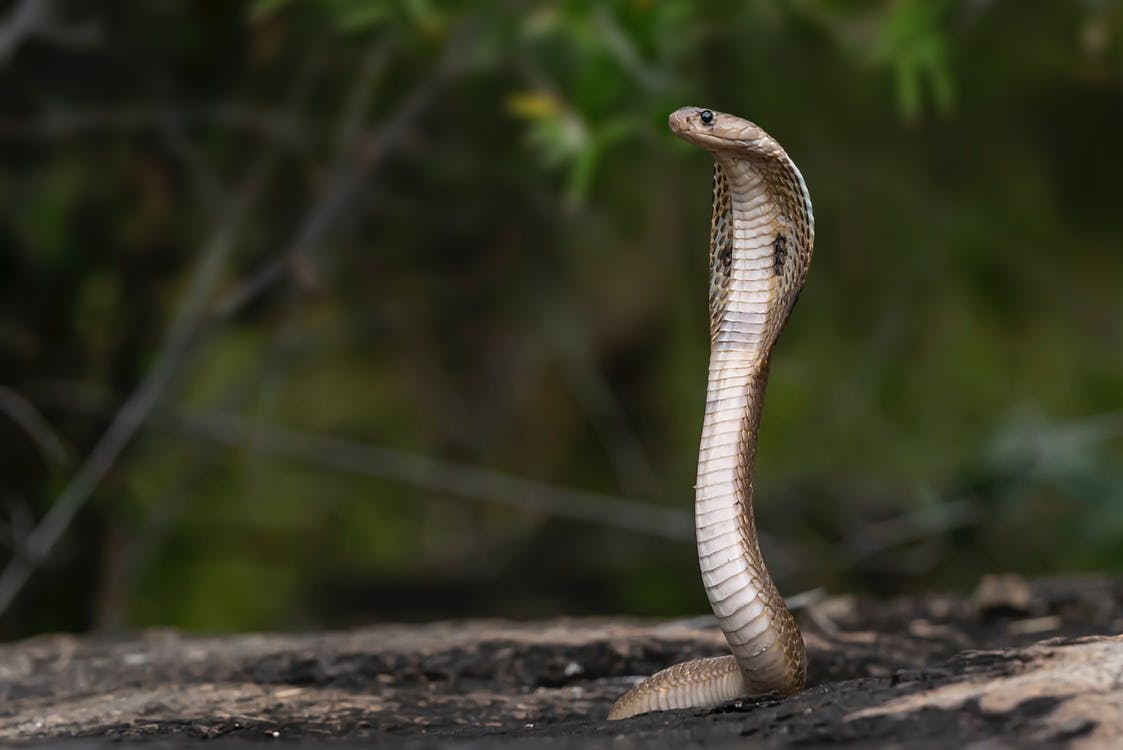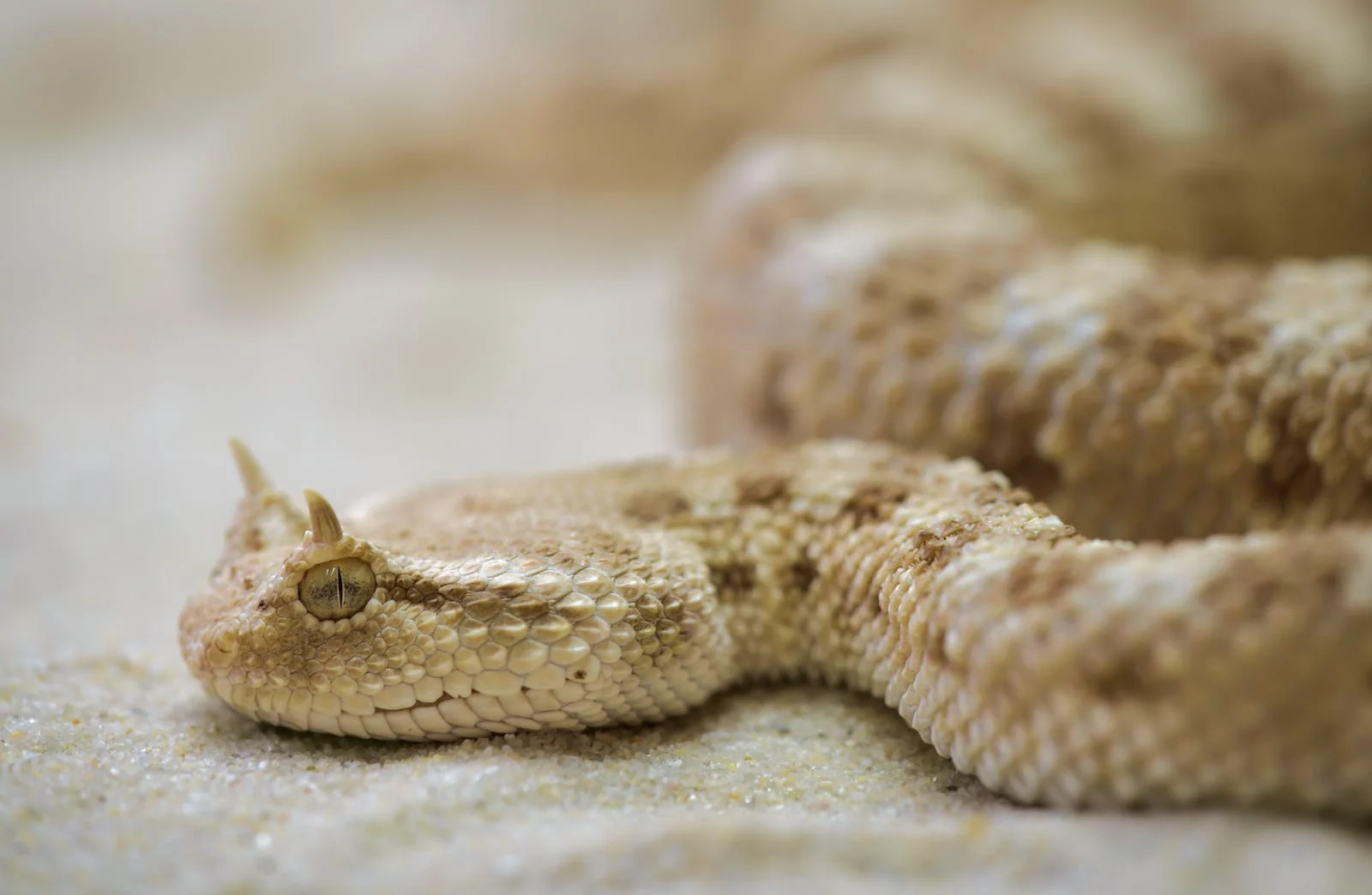Reptiles
Some 450 species of snake are venomous. Snake venom is produced by glands below the eye (the mandibular glands) and delivered to the target through tubular or channelled fangs. Snake venoms contain a variety of peptide toxins, including proteases, which hydrolyse protein peptide bonds; nucleases, which hydrolyse the phosphodiester bonds of DNA; and neurotoxins, which disrupt signalling in the nervous system. Snake venom causes symptoms including pain, swelling, tissue necrosis, low blood pressure, convulsions, haemorrhage (varying by species of snake), respiratory paralysis, kidney failure, coma, and death. Snake venom may have originated with duplication of genes that had been expressed in the salivary glands of ancestors. Venom is found in a few other reptiles such as the Mexican Beaded Lizard, the Gila Monster and some monitor lizards, including the Komodo Dragon. Mass spectrometry showed that the mixture of proteins present in their venom is as complex as the mixture of proteins found in snake venom.

Cobras
Common name: Cobra
Family: Elapidae
Genus: Naja
Distribution: Regions throughout Africa, Southwest Asia, South Asia, and Southeast Asia.
Venomous or poisonous?: Venomous
Venom: All of the known cobras are venomous and many are capable of rearing upwards and producing a hood when threatened. All true cobras are capable of delivering a fatal bite to a human. Most species have strongly neurotoxic venom, which attacks the nervous system, causing paralysis, but many also have cytotoxic features which cause swelling and necrosis, and have a significant anticoagulant effect. Some also have cardiotoxic components to their venom.
Interesting facts: Several species have evolved the ability to “spit” venom which can cause a burning sensation if it enters the eye and even lead to blindness if not washed immediately and thoroughly. The “King Cobra” is in fact not a cobra but rather belongs to the genus Ophiophagus.

Vipers
Common name: Viper
Family: Viperidae
Subfamilies: Azemiopinae (Fea's vipers), Causinae (Night Adders), Crotalinae (Pit Vipers), Viperinae (True Vipers)
Distribution: Vipers are found in the Americas, Africa, Eurasia, and South Asia. In Europe, Asia and Africa, vipers are found everywhere except Siberia, Ireland, Norway and Sweden.
Venomous or poisonous?: Venomous
Venom: Viperid venoms typically contain an abundance of protein-degrading enzymes called proteases which produce symptoms such as pain, local swelling and necrosis, blood loss and disruption of the blood-clotting system. Viper venom may also cause damage to blood vessels and haemolysis. Death is usually caused by collapse in blood pressure.
Interesting facts: Captopril was the first ever ACE Inhibitor, a class of drugs used for treating high blood pressure and congestive heart failure, and is an analogue of a peptide found in the venom of the viper Bothrops jararaca.

Heloderma Lizards
Common name: Mexican beaded lizard (Heloderma horridum) or Gila monster (Heloderma suspectum)
Family: Helodermatidae
Genus: Heloderma
Distribution: America, Mexico and Guatemala.
Venomous or poisonous?: Venomous
Venom: Although the Gila monster's bite is normally not fatal to healthy adult humans, it is generally regarded as the most painful venom produced by any vertebrate. Its venom may cause haemorrhage, lethargy, partial paralysis of the limbs or hypothermia. The beaded lizard's venom is a weak hemotoxin, and although human deaths are rare, it can cause respiratory failure. Almost all documented human bites (eight in the past century) have resulted from prodding captive lizards with a finger or bare foot.
Interesting facts: Exenatide (marketed as Byetta), used in the management of Type-2 diabetes, is a synthetic drug designed from the protein exendin-4, isolated from the Gila monster's venom. Venom from both Gila Monster and Beaded Lizard venom have shown an inhibitory effect in lung cancer.

Rattlesnakes
Common name: Rattlesnake
Family: Crotalinae
Genus: Crotalus and Sistrurus
Distribution: Native to the Americas, ranging from British Columbia through Ontario in southern Canada, to central Argentina.
Venomous or poisonous?: Venomous
Venom: Rattlesnake venom is hemotoxic, destroying tissue, causing necrosis and coagulopathy (disrupted blood clotting) and may lead to paralysis. Common symptoms include swelling, severe pain, tingling, weakness, anxiety, nausea and vomiting, hemorrhaging, perspiration, and (rarely) heart failure. Rattlesnakes are the leading contributor to snakebite injuries in North America, but rarely bite unless provoked or threatened; if treated promptly, the bites are seldom fatal.
Interesting facts: Rattlesnakes receive their name from the rattle located at the end of their tails, which makes a loud rattling noise when vibrated that deters predators or serves as a warning to passers-by.